
|

|
Forum Index : Solar : 48volt flat packs
| Author | Message | ||||
| Warpspeed Guru Joined: 09/08/2007 Location: AustraliaPosts: 4406 |
Yup, my sentiments exactly. Just one example, cutting a rectangular hole in a panel for a meter. Doing it with a file is a bastard of a job, getting the edges square, and the right dimensions takes patience. Dead easy on a mill to get everything spot on. I can do a lot on my lathe, but many things will be far easier on a mill. Cheers, Tony. |
||||
| Davo99 Guru Joined: 03/06/2019 Location: AustraliaPosts: 1577 |
Good on you Tony! I hope you enjoy every moment using it and get great satisfaction from the jobs you can do with it. I always wanted to learn about metal working. I nursed my Father in law through cancer and one of the plans we had together when he was better was for him to teach me how to use the shed full of lathes, Mills, surface grinder and shapers he had. He'[d been an engineer / machinist before becoming manager of the aerospace co he worked for and said he missed being on the tools which was why he had plenty at home. We never got to him teaching me as just as everyone, doctors included thought he had it beat, It flared up again and he was gone in a few weeks. My brother in law got everything and I don't think any of it has been used since he grabbed it. I have been running round getting my 82 Yo father quotes for a new Tractor. Another new tractor that is. A big mother. He said to me yesterday, " Do you think I'm kidding myself buying something like this at my age? " I said if it gives you some enjoyment Dad and another day of life, then it's worth it. I think he wants it but is a bit worried about what other people Might think. I spoke to the Mrs and I ordered him the Flail mower he is procrastinating on anyway. That was $3600 plus some spares I ordered with it so close enough to $4k so you can tell your Mrs your toy was cheap Tony. When the thing shows up, Dad won't need to think about it any more, he'll have it so that will be that. I reminded him of what he has said about other people" Are you going to get them to print $1000 Notes so you can take it all with you when you kick the Bucket? If not spend it and enjoy it." One trick for getting Toys past the Chief cook and Bottle washers..... Soon as you get something, do something for them with it. My mrs wasn't real convinced we needed a Tractor Till I told her to step aside from the garden she was struggling to pull the old plants out of and came along and did it in one fell swoop. Then I made a Ripper for it and cut a new edge for the garden and a Furrow to put the new plants in without her having to dig. Also Used the Jib Crane I built to move some Big planter pots she has that I couldn't Budge in a million years. Heard her telling Dad the other day " I don't know how we got on without the tractor" Once they benefit from something then it's all good. I'm trying to keep everything to about 350 Kg now because up to that I can move things ( including the Lister engine) with no problems with the tractor. I have -Read- a number of posts/ threads on other sites where people talk about compressing these type of batteries to keep them from swelling and a recent thread from someone saying they though their NEW batteries were duds because they were slightly Swelled. The numerous replys were about how to build Frames from all thread rod and end plates to pull the things together to stop them expanding and pull them back into shape. They look a similar type pack to me. Are you going to replace these batteries Tony or run what you have left with a little less capacity? |
||||
| Warpspeed Guru Joined: 09/08/2007 Location: AustraliaPosts: 4406 |
When one cell failed, I just bridged it out, so there was then 3.3 volts less. Then a second cell failed, 6.6 volts less. With three now gone, the total battery voltage was getting down to the point that the Warpverter was not happy first thing in the mornings under load before sun up, so I just disconnected the whole battery at that point. The thirty cells are stacked 6 x 5 between two sheets of 6mm steel plate. The steel plates are held together by twelve lengths of 6mm all thread. The nuts are just nipped up, finger tight plus one turn.  That all fits perfectly into a standard filing cabinet drawer, with just a few extra mm of space all around. It makes for a very neat installation, highly recommended. It would also work very well for a 48v system where cells could be paired, giving 15 cell pairs and 50v nominal.  The whole battery cannot really swell, but one cell can, but only very slightly. And that is what you can see, its only a few mm bulge, but its definitely there on all three cells. Not sure what I will do yet. Probably first thing will be to cost out some refurbished fork lift batteries before next winter. If that turns out to be outrageously expensive, I may just replace the three Winstons and then see if any more are going to fail. Edited 2020-12-03 07:19 by Warpspeed Cheers, Tony. |
||||
| Davo99 Guru Joined: 03/06/2019 Location: AustraliaPosts: 1577 |
That is a Bloody Clever and neat setup indeed. Brilliant. My neighbour is a Filing cabinet fan, some of the things he has done with them is very clever too in the way of storage of tools in a neat and orderly way and even housing small machines. I am on the lookout for some already. Do you know of other reports of these batteries falling over prematurely or is it just a bad batch you seem to have? that is always my luck! It's a bit of a problem. If you buy replacement cells and more fall over you are back to square one, If you don't then the whole lot are useless. Quite the quandry. Are you able to re set your inverter to accept a lower voltage and run with less capacity? Other thing I'm sure you would be well awake to now after getting the Mill would be moving forklift batteries. If you have a shed they could be wheeled into off the back of a Truck on a pallet jack or something no problem. Otherwise..... I believe they usually come in a steel caseing. That's a weight in itself. If you got them separate it would make them easier to move and you might get a few bucks off for the casing as well. I spose Being in Vic you have one of those lousy smart meters? I was checking out my dads power Bill from a couple of weeks back last night. His previous (Winter) one was a tad over $500. I upgraded his solar a couple of weeks before the last read but this bill came out at $203. Being in the country, his unavoidable " Connection " charges were $171 of that. 2 weeks in he's already 37 Kwh up on what he has used. I told him, get stuck into that AC, It's not costing you a cent at this stage. Having near doubled the solar he's going to have power to burn for the next 2 quarters. I don't expect winter will be much better but 3 out of 4 isn't bad. I'll see how he goes when I'm back up there in a couple of weeks. I'm thinking might have to shut the solar down for a half the quarter so he does not get too far ahead. If all this Climate crap were just not a Money spinner, we would be allowed to back feed and use the grid as a battery with a 1:1 Return like they can in places like Canada where the power is basically averaged out over a year. Friend sent me a Solar quote the other day to review for him. It was from Origin and they are offering a 28C Kwh flat buy rate, .15 Kwh off peak and a .20C kwh FIT. No mention how long the FIT is for but obviously a year. Mate said the guy had been back to him trying to push the deal through. I said tell him if they will give you a written contract with the FIT being that for 5 Years you'll sign up today. The install price was a bit higher but with that sort of FIT he'd have things paid back in about 2.5 years or maybe even less. If you got a big enough forklift pack you may be able to go off grid with your power all together. How much you pay in Connection charges where you are Tony? |
||||
| Warpspeed Guru Joined: 09/08/2007 Location: AustraliaPosts: 4406 |
I quite like my smart meter, I can log into my suppliers website and get an hour by hour graph of consumption, plus daily, and monthly energy totals. It makes any improvements to my solar system quite apparent. Fixed supply charge here is $83 for ninety days, but I get a fixed pensioner rebate of $30. There is also in addition to that a $33 annual concession, not sure why. So about $45 plus the cost of actual electricity consumed (at 29 cents Kwh) every three months. Typical electricity bills here range anywhere from $45 to $100, so there is not a great financial incentive to sink thousands of dollars into a huge battery. All the the fork lift batteries I have seen are usually constructed as a giant metal box that can be removed as a complete plug in module with a fork lift, and the larger ones are incredibly heavy. One giant very heavy immovable cube!  On the other hand, large commercial stationary batteries commonly have all the cells lined up in rows on shelving, and cells can be maintained or removed individually. So shifting or installing a whole large battery could be done one cell at a time. I am sure the battery supplier would supply just bare cells without the heavy metal box, which would just be an expensive and useless addition.   Edited 2020-12-04 02:42 by Warpspeed Cheers, Tony. |
||||
| Davo99 Guru Joined: 03/06/2019 Location: AustraliaPosts: 1577 |
Taking the individual cells out of the steel container would definitely make the things more manageable. I find anything up to about 220 Kg can be handled with not too much effort with a Simple $30 Hand trolley. I think the individual cells of a 48V forklift pack would come in well under that. The whole things weigh in at a Minimum half and more commonly, 1 Ton. One does get decent KWH though. Unfortunately, unlike panels, There seems to be no cheap practical supply of batteries. I'd like to try an off grid type setup but just no way to justify the cost. Those DIY used 18650 setups look interesting but a LOT of work and not all that cheap either by the time you get something of practical size. |
||||
| Warpspeed Guru Joined: 09/08/2007 Location: AustraliaPosts: 4406 |
I suppose it depends on the size of the fork lift and the battery. From what I am told, the basic idea is that a fork lift should be able to be totally thrashed by a minimum wage idiot, for a full eight hour working shift, and be able to fully recover with an overnight eighteen hour recharge. If it begins to slow down near knock off time, the minimum wage idiot complains to his supervisor, and management fits a brand new battery. So a lot of pretty good batteries do get trashed, and might be gold for us solar crazies. A different scenario is the people that sell second hand fork lifts from companies that go bankrupt.... Nice forklift, very few hours, brand new battery only $xx,xxx. So the original battery might be down a bit, but again if the forklift sales shark can get more than scrap value, he is very likely to sell it to some gullible solar worthy. Don't really know a lot about the fork lift industry, but I used to fix a lot of the fork lift electronics, and have designed battery chargers for the industry, and have heard the stories.... Cheers, Tony. |
||||
| Haxby Guru Joined: 07/07/2008 Location: AustraliaPosts: 419 |
Was the output voltage just dropping below 240v or were there other symptoms? |
||||
| Warpspeed Guru Joined: 09/08/2007 Location: AustraliaPosts: 4406 |
My Warpverter is set up to run between 90v and 180v. Below 90v it drops out of voltage regulation, and the 235v ac output falls in proportion to any further input voltage reduction below that. Now with 30 cells, I can work down to 3.0 volts/cell with very solid voltage regulation, all the way down, which is fine. In fact the under voltage battery disconnect trips at 3.1v on the lowest cell. With only 27 cells, voltage regulation stops working at 3.33 volts per cell, which only allows me less than half the rated battery capacity. Lithium cells have a very flat voltage characteristic, and a relatively high voltage per cell which is good. But trying to run with 10% of the cells missing is just too much. Cheers, Tony. |
||||
| Davo99 Guru Joined: 03/06/2019 Location: AustraliaPosts: 1577 |
I was wondering what the DOD for forklift batteries are? I surmised it was like any other LA battery where 50% would be the ideal Minimum but they would go further without totally crashing too fast like with a Non deep cycle. I spose even if one had a battery that was somewhat depleted in capacity, by only discharging it to 50% or 70, the fall off would be greatly reduced over time and good life could be had from them. I'll also bet the Draw put on fork batteries is magnitudes higher than would normaly be put on them with offgrid type use and being stationary, the banging and vibration would not be there either. Solar should be a walk in the park for these batteries compared to what their designed use is. The people I have read of and the few I have spoken to in person that have LA batteries all seem to get 10 as a Minimum years life out of them and 15 and 20 years is not uncommon either. Spoke to a Dairy farmer the other week whom has been off grid forever and he said his first batteries lasted him 14 years and the ones he has now he's had 18 and they are still going fine. I guess the technology is refined as the years go by so they should last incrementally longer with each generation. |
||||
Revlac Guru Joined: 31/12/2016 Location: AustraliaPosts: 961 |
Most of the info will be on This place. or there warranty section "A cell is deemed to have failed if it cannot deliver 80% of it's C5 capacity." There are others that do the battery maintenance as well, rather than leave it to the operators. Edited 2020-12-06 15:11 by Revlac Cheers Aaron Off The Grid |
||||
| Davo99 Guru Joined: 03/06/2019 Location: AustraliaPosts: 1577 |
This is their new battery warranty conditions page but looks great from a home power POV. https://www.ceilpower.com.au/forklift-battery-warranty/ So 5 years warranty to a max Discharge of 80% @ C5 rate. Wow! Sounds more like a they are doing one a favour rather than putting on a condition! The rest is all pretty favourable as well, battery can't be 09ver 50oC, must be recharged asap, don't store the thing flat, top up the water.... Things a homeowner would be keen to do anyway to protect their investment. The thing about the battery failing if it is not 80% capacity at c5 is interesting. I wonder what they do with these failed Cells? One would expect they would be sold for scrap. Even 70% capacity at c5 Is probably 90% or better at something like the standard C20. One may be able to pick these batteries up at a bit over scrap price if one asked nicely. If these batteries are rated at C5, they must be well over the stated capacity one would assume going on the standard c20 which means a smaller, cheaper pack could be used than maybe assumed if one were thinking standard capacity rating. Even a used and somewhat deteriorated pack could give the full capacity one was thinking of. What discharge rate are lipos normally rated at? The more I learn about these forklift batteries the more appealing they become. |
||||
| Warpspeed Guru Joined: 09/08/2007 Location: AustraliaPosts: 4406 |
I just cannot believe that. A C5 discharge rate means a 100 amp hour battery discharged at 500 amps over 12 minutes (1/5 of an hour). No lead acid battery can possibly do that. If it were possible we would be using lead acid batteries in all our drones ! Standard way of rating general purpose lead acid batteries is over a ten hour discharge rate or C0.1 so a 100 amp hour battery could deliver 10 amps for 10 hours. Sometimes batteries for special purposes have other ratings such as C0.05 or C0.2 for example. The ten hour rate would be about right for a fork lift battery that operates over an eight hour shift, and it makes no sense to use anything other than the C0.1 rating. It would be about right for over night solar storage applications as well. Reference battery university, which is the holy grail. https://batteryuniversity.com/index.php/learn/article/how_to_measure_capacity If some battery salesman ever mentioned 20C with relation to a lead acid battery, I would run for my life. That would suggest a three minute discharge time from a fully charged battery, down to the fully discharged end point, wow , like WOW. Edited 2020-12-07 08:21 by Warpspeed Cheers, Tony. |
||||
| Davo99 Guru Joined: 03/06/2019 Location: AustraliaPosts: 1577 |
I have come across this before Tony. There are 2 Different Calculations or at least specifications for C rate. There is the one you are talking about which I believe is the correct one and there is another which was what I have always taken it as I learned it from battery manufacturers and is clearly what they are applying here. As I understand it, it is the rate you can discharge the battery in hours before it falls to the point of which it is said to be Discharged ( depending on the end voltage specified ) or the DOD specified, in this case 80%. In this case they are talking about the amount of amps you can pull off the battery to reach that end point in 5 Hours. Yes, I know that is not the proper specification but it is the specification battery manufacturers use or at least some of them and makes sense in this example. I used to do a lot with this battery company which is where I learned and understood the ratings. Seems they still use the same parameters although I no longer see it specced as C rate. I can't link the sheet but if you look on this page and download the Data sheet, they Specify different Hour discharge rates and end voltages. Maybe that is called something else ( hourly Rate) but I have seen it called the C rate and it is the capacity of a battery in hours with a discharge rate over that time. https://www.power-sonic.com/product/pdc-121000/ In this case I see the battery is 100 Ah @ the 20 Hour rate and at the 5 hour rate it is 79 Ah. They specify the discharge to 10.50 V. At the 1 Hr Rate it's 58 Ah and down to 9V. ( EEK!) In the case of the fork Batterys, I would surmise they are at least 20% more capacity at the 20 Hr rate than their 5 Hr rating specified to whatever voltage 80% Discharge is which is probably a lot more than the 42 V it would work out at as these battery's are specced. If the things are Failing at less than 80% capacity @ the 5 hr rate, then they would be pretty damn close to full spec as I always take standard ratings at 20 Hr. Going as a rough guide, if this battery could do 5A for 20 Hours and is 100Ah, then a 700 Ah 48V fork battery should be able to do around 35A or 1.6 Kw Continuous for 20 Hours. Much more than would be practically used I think and in that 20 hours you are going to have some recharge at least depending on weather if not a full recharge with a solar setup. Going to take a lot to get that down to 80% Dod with any decent solar setup. One thing with a fork battery, being the size it is one could get Lipo like recharge capacity up to 80% anyway. I suspect the amount of amps they could take even for the end charge would be as much as one could practically pump in with a home setup and still a good rate ever from a generator. The C rate terminology may not be precise or as some understand it, but when put in context of the way they are specifying it in hour discharge rate, these fork batteries are pretty impressive to me. |
||||
| Warpspeed Guru Joined: 09/08/2007 Location: AustraliaPosts: 4406 |
Yes there are many different ways of stating battery capacity, but the "C" rate of discharge has a definite and very specific meaning. If you want to talk about hold up time, that is also valid, but its the inverse of rate of discharge and a very different thing. There cannot be multiple interpretations for a basic engineering unit! Sometimes you will find hold up time referred to as C by sales people that should know better. You will never find hold up time written as C in any engineering dictionary or reference work written by an engineer. Even the infamous Wikipedia has this right: https://en.wikipedia.org/wiki/Battery_charger Cheers, Tony. |
||||
| Davo99 Guru Joined: 03/06/2019 Location: AustraliaPosts: 1577 |
Is there a term/ specification/ Correct name for what the battery manufacturers are using? Seems a number in the battery industry are using this rating so one would hope they have a Correct term for it that differentiates it from the Correct definition of C rate. |
||||
| Warpspeed Guru Joined: 09/08/2007 Location: AustraliaPosts: 4406 |
Hold up time is a fairly typical term, especially for something like a UPS. A laptop computer may have a similar rating for how long you can run the thing off the internal battery before it dies. Those sorts of ratings are usually given for equipment by the equipment manufacturer. A battery supplier will (or should) always use C.  The interesting thing about those curves for lead acid is its C/20 or C DIVIDED by 20 which is twenty hours down to the end point of 1.7 volts. Note its the slowest discharge rate over the longest time. Strictly speaking that is wrong and confusing, it should be written as C0.05 Someone that did not know might see that as C20, which probably explains all the confusion. A very big difference between 3C or C3 and C/3. Edited 2020-12-07 11:24 by Warpspeed Cheers, Tony. |
||||
| BenandAmber Guru Joined: 16/02/2019 Location: United StatesPosts: 961 |
did any one talk about lto be warned i am good parrot but Dumber than a box of rocks |
||||
| oreo Newbie Joined: 11/12/2020 Location: CanadaPosts: 39 |
I am planning on using some Lifepo4's. Battle Born recommends floating from 3.35-3.45v On the A123 datasheet, they recommend 3.45v It's disappointing that you're getting failures. Are you actually floating the cells, or just charging to 3.45 and then disconnecting? Greg Greg |
||||
| Warpspeed Guru Joined: 09/08/2007 Location: AustraliaPosts: 4406 |
What happens when you charge Wistons, the voltage very slowly rises over a few hours. When it gets to about 3.45v the rate of voltage rise suddenly accelerates. At 3.5v the voltage is rising at a fantastic rate, it just goes exponential. Now if you have a very large series string of many cells, one particular cell might reach 3.45v ahead of all the others, and suddenly "take off". There is really no point in charging to much higher voltage, that I can see. Suppose it takes three hours to reach 3.45v, ten minutes to hit 3.5v and twelve minutes to hit 3.8v. How many extra amp hours do you get over the last few minutes ? Permanent battery damage occurs above 4.0v supposedly. I don't think I am losing much capacity by terminating charging when the highest voltage cell reaches 3.45v. I have noticed a very similar effect at the low voltage end of discharge point. One cell will be lower than the others, and the voltage of that low cell drops like a stone compared to all the others. Best to have a low voltage disconnect that trips when the lowest cell hits the limit, in my case 3.1v I charge at full current until the highest voltage cell hits 3.45v, then charging completely terminates. It stays off until total darkness when solar voltage falls to zero. That resets the system. At dawn, charging re commences at full available current. From what I have read, that is the optimum strategy. But three cells have still died. So if I am doing it all wrong, I have no idea what needs to be changed. Cheers, Tony. |
||||